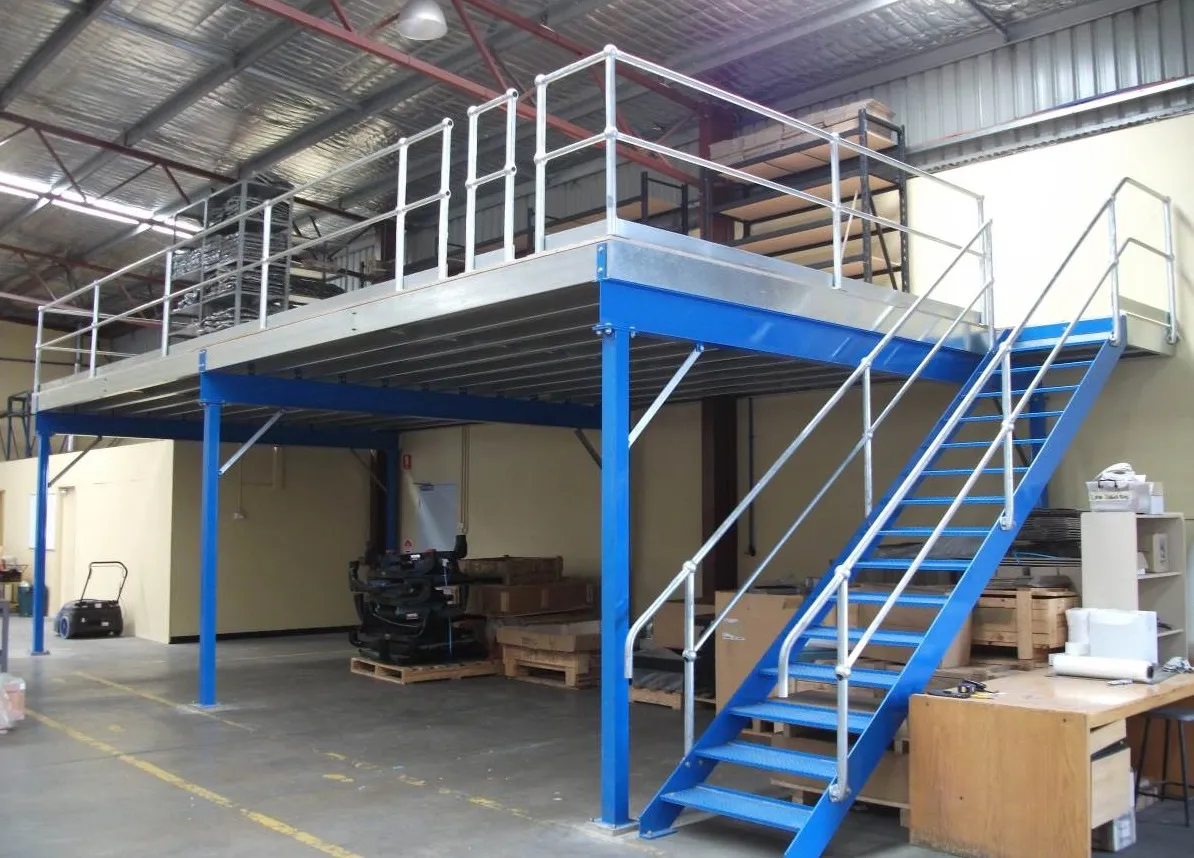Want to unlock hidden potential in your shop? A mezzanine floor might be the answer! This comprehensive guide covers everything from safety and design to materials and innovation, ensuring your project is a success.
Planning Your Shop Mezzanine Floor: Key Considerations Before You Begin
Before diving into construction, consider these essential factors:
Essential Considerations
- Safety First, Always: Mezzanines must meet building code requirements for railings, ladders, stairs, and load capacity. Prioritize the safety of employees and customers accessing this new level.
- Making Your Mezzanine Work Smart: How will your mezzanine optimize your shop’s efficiency? Consider its potential for storage, streamlined production, office space, or a combination of needs.
- Solid as a Rock: Ensuring Structural Stability: A structural engineer will calculate load capacity, factoring in the combined weight of the structure, equipment, inventory, and occupants. Proper column placement and support structures are crucial.
- Breathing Easy: Ventilation and Cleanliness: Adequate ventilation is essential to maintain air quality on and below the mezzanine. Incorporate design elements that allow for easy cleaning and dust control.
Key Takeaways:
- Safety is Paramount: Compliant access points, secure railings, and accurate load calculations are non-negotiable.
- Space Optimization: Strategically design your mezzanine to address your shop’s specific needs, whether storage, workflow, or expanded work areas.
- Structural Integrity is Non-Negotiable: A qualified engineer ensures your mezzanine’s design and construction meet safety standards.
- Cleanliness and Ventilation Matter: Prioritize a healthy work environment through proper ventilation and easy-to-clean surfaces.
Designing a Safe and Code-Compliant Shop Mezzanine Floor
Designing your mezzanine involves careful planning:
Making the Most of Your Space
Mezzanines effectively double your usable square footage without the cost of a full-blown extension. This makes them ideal for increasing inventory storage, accommodating equipment, or adding new office space.
Custom-Fit Mezzanines: Like a Glove!
Tailor your mezzanine to perfectly match your workflow and needs. Customize the size, load-bearing capacity, and even the flow of movement around and within the structure.
Safety First: Building Codes Are Your Friend
Building codes ensure your mezzanine is secure and meets important safety standards. These codes offer guidelines on structural stability, fall prevention, and more.
Teamwork Makes the Dream Work: Finding the Pros
Experienced mezzanine designers and manufacturers are essential partners. They bring expertise in design, engineering, and industry standards, ensuring a successful project that meets your specific requirements.
Bonus Tips for an Awesome Mezzanine
- Automation Integration: Enhance efficiency even further by integrating automated systems into your mezzanine design.
- Going Green: Opt for eco-friendly materials and sustainable design practices for a reduced environmental impact.
- Real-World Inspiration: Explore how other businesses have successfully incorporated mezzanines into their workflows.
By following these guidelines and working with experienced professionals, your shop mezzanine will be a valuable addition that is both safe and functional.
Choosing the Right Materials and Construction Methods for Your Mezzanine
The materials and construction methods you choose impact the durability, aesthetic, and functionality of your mezzanine:
Materials: Strength and Style
- Steel: Known for its exceptional strength, durability, and versatility, steel is a popular choice for mezzanine construction. It’s ideal for heavy loads and can be customized to various designs.
- Other Materials: While steel is a common choice, explore alternative materials like wood if they better suit your shop’s aesthetic or specific needs.
Construction Methods: Pre-Engineered vs. Custom
- Pre-engineered Mezzanines: A cost-effective and efficient option, pre-engineered mezzanines utilize pre-designed components for easy assembly on-site.
- Custom-designed Mezzanines: When you need a truly unique solution or have an unusual space, custom mezzanines offer tailored designs to fit your exact specifications.
Safety & Compliance: Non-Negotiables
Regardless of your material and construction choices, prioritize safety and adherence to building codes:
- Building Codes & Industry Standards: Meeting building codes and industry standards is crucial for ensuring the safety and structural integrity of your mezzanine.
- Professional Engineer: Consult with a qualified engineer to ensure your design meets all safety regulations and load-bearing requirements.
Here’s a quick summary of key considerations:
| Factor | Considerations |
|---|---|
| Materials | – Steel offers exceptional strength and durability |
| – Explore alternative materials to match your aesthetic vision | |
| Construction Methods | – Pre-engineered mezzanines provide cost-effective and efficient installation |
| – Custom-designed mezzanines offer tailored solutions for unique spaces and needs | |
| Safety & Compliance | – Adhere to all building codes and industry standards |
| – A professional engineer provides essential oversight for design and construction |
Choosing the right materials and construction methods is a balancing act between your vision, budget, and safety requirements. By carefully evaluating your options and working with experienced professionals, you’ll create a functional and visually appealing mezzanine that perfectly suits your shop.
Building Regulations and Energy Modeling
For additional guidance on building regulations and energy modeling, refer to these resources:
- Building Regulations Application Mezzanine Office
- How to Treat Open Mezzanine Floor in Energy Modelling
Learn more about building construction services:
Key Points for Building a Shop Mezzanine Floor:
Safety First:
- Load Capacity: Determine the maximum load the mezzanine can safely support through structural engineering calculations.
- Safe Access: Provide secure and accessible means of reaching the mezzanine, such as stairs or an elevator, that comply with building codes.
- Fire Safety: Implement fire safety measures, including sprinklers, fire-resistant materials, and clearly marked evacuation routes.
Customization:
- Size and Shape: Tailor the mezzanine’s size and shape to optimize space utilization and seamlessly integrate with the existing layout.
- Storage Solutions: Choose storage solutions that align with your needs, such as racks, shelving, or open floor plans for maximum flexibility.
Code Compliance:
- International Building Code (IBC): Adhere to the guidelines outlined in the International Building Code (IBC) for mezzanine construction, ensuring safety and compliance.
Innovative Features:
- Energy Efficiency: Enhance energy efficiency with smart lighting choices, proper insulation, and energy-efficient HVAC systems.
- Technology Integration: Integrate technology, such as inventory management systems, automation, or smart lighting controls, to streamline operations and improve efficiency.
Planning Your Shop Mezzanine Floor: Key Considerations Before You Begin
Key Considerations:
- Prioritize Safety with Compliant Access and Egress: Ensure all mezzanines have secure railings, ladders, or stairs that meet building codes for easy and safe access.
- Maximize Efficiency through Space Optimization: Utilize mezzanines to create additional floor space, allowing for better inventory storage, production flow, or office expansion.
- Consider Structural Implications: Plan for load capacities, column placement, and support structures to ensure the mezzanine’s stability and safety.
- Maintain a Clean and Ventilated Environment: Design mezzanines with proper ventilation and cleaning access to prevent dust accumulation and health hazards.
Condensed & Organized Context:
Safety
- Prioritize safety by installing secure railings, ladders, or stairs that comply with building codes.
Design
- Mezzanines should be designed to optimize space utilization for storage, production, or office expansion.
- Consider aesthetics to integrate the mezzanine seamlessly with the existing space.
Type
- Select the appropriate mezzanine type (e.g., free-standing, structural) based on intended use and load requirements.
Size
- Determine the optimal mezzanine size to maximize space utilization without compromising safety or accessibility.
Structural Changes
- Assess potential structural changes required to accommodate the mezzanine, such as column placement and reinforcement.
Cleanliness
- Maintain a clean mezzanine environment by ensuring proper ventilation and accessible cleaning points.
Purpose
- Clearly define the purpose of the mezzanine to guide design decisions and maximize its functionality.
Ventilation
- Provide proper ventilation to prevent dust accumulation and ensure a healthy work environment.
Unique Insights:
- Ergonomic Considerations: Explore the potential for incorporating ergonomic features into the mezzanine design, such as adjustable work surfaces and proper lighting.
- Sustainability: Investigate environmentally friendly materials and design practices for the mezzanine, such as energy-efficient lighting and recycled materials.
- Future Expansion: Consider the potential for future mezzanine expansion or reconfiguration to accommodate changing business needs.
Designing a Safe and Code-Compliant Shop Mezzanine Floor
Minimum 4 Key Lines:
- Maximize Space and Optimize Functionality: Industrial mezzanines provide an effective solution to increase warehouse or workspace area without expanding the building footprint.
- Tailor-made Designs for Unique Requirements: Custom mezzanine designs allow for versatility and cater to specific space constraints, load capacities, and workflow needs.
- Ensuring Safety and Compliance: Adhering to mezzanine building codes, such as OSHA and IBC, ensures compliance, protects employees, and guarantees structural integrity.
- Professional Expertise for Optimal Outcomes: Partnering with experienced mezzanine designers and manufacturers ensures adherence to industry standards, resulting in safe and efficient solutions.
Condensed & Organized Context:
- Space Optimization: Mezzanines leverage vertical space to expand storage or create additional areas for various operations, increasing efficiency and minimizing space constraints.
- Custom Design Considerations: Mezzanine designs can be tailored to accommodate varying load capacities, workflow requirements, and available space, providing flexibility and maximizing functionality.
- Safety and Code Compliance: Building codes like OSHA and IBC outline regulations for mezzanine construction, ensuring structural stability, adequate clearances, and fall protection measures for worker safety.
- Professional Guidance: Collaboration with reputable mezzanine designers and manufacturers provides expertise in design, engineering, and installation, ensuring compliance and delivering optimal results.
Unique Insights:
- Exploring Integration with Automation: Investigate the potential integration of mezzanines with automated systems, such as conveyors or automated storage and retrieval systems (ASRS), to enhance warehouse efficiency.
- Sustainability and Green Building Practices: Consider the inclusion of sustainable materials and practices in mezzanine design, aligning with environmental initiatives and contributing to corporate social responsibility efforts.
- Case Studies and Best Practices: Incorporate real-world examples and case studies to demonstrate the successful implementation of industrial mezzanines, providing valuable insights into industry practices.
Choosing the Right Materials and Construction Methods for Your Mezzanine
Key Lines:
- Optimize Space Maximization: Utilize mezzanine floors to enhance vertical storage capacity, addressing space constraints and expanding operations.
- Ensure Structural Safety and Compliance: Adhere to industry standards and codes to guarantee stability and minimize risks, ensuring the well-being of personnel.
- Consider Material Durability and Aesthetics: Select appropriate materials that offer longevity, withstand wear and tear, and complement the existing interior design.
- Customize Design for Specific Applications: Tailor mezzanine floor layouts, load capacities, and features to specific industrial or commercial needs, optimizing performance.
Condensed & Organized Context:
Material and Design Considerations:
- Choose materials that prioritize durability, safety, and aesthetics.
- Consider the purpose and environment of the mezzanine to determine optimal materials.
Structural Safety and Codes:
- Adhere to OSHA and industry standards to ensure structural integrity and safety.
- Employ proper design and engineering practices to meet load capacity requirements.
Space Optimization:
- Utilize mezzanines to maximize vertical storage capacity, expand operations, and improve efficiency.
- Plan layouts and dimensions to enhance workflow and maximize utilization.
Customization and Applications:
- Tailor mezzanine designs to specific needs, such as load capacity, floor layout, and access points.
- Consider load capacity, vertical clearance, and integration with existing structures.
Unique Insights:
- Integrating Mezzanines for Multi-Level Operations: Explore case studies of businesses successfully leveraging mezzanines to create multi-level workspaces or storage facilities.
- Advanced Design Software for Mezzanine Optimization: Discuss the role of software tools in optimizing mezzanine design, such as load analysis and space planning.
- Sustainable and Energy-Efficient Mezzanine Design: Highlight eco-friendly materials and design practices that reduce environmental impact and energy consumption.
- 70+ Charming Flowers That Begin With C: A Visual Guide with Growing Tips - April 22, 2025
- How to Identify a Ground Wasp Nest: A Visual Guide - April 22, 2025
- Best Foldaway Poker Tables of 2024: Buyer’s Guide & Reviews - April 22, 2025










